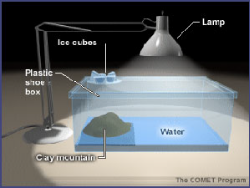Education: Activities & Documents
The Water Cycle - Now You See It, Now You Don't

Evaporation drives the water cycle. Evaporation from the oceans is the primary mechanism supporting the surface-to-atmosphere portion of the water cycle. After all, the large surface area of the oceans (over 70% of the Earth's surface is covered by the oceans) provides the opportunity for such large-scale evporation to occur. On a global scale, the amount of water evaporating is about the same as the amount of water delivered to the Earth as precipitation. This does vary geographically, though. Evaporation is more prevalent over the oceans than precipitation, while over the land, precipitation routinely exceeds evaporation. Most of the water that evaporates from the oceans falls back into the oceans as precipitation. Only about 10% of the water evaporated from the oceans is transported over land and falls as precipitation. Once evaporated, a water molecule spends about 10 days in the air. The process of evaporation is so great that without precipitation, runoff, and discharge from aquifers, oceans would become nearly empty over time.
Condensation is the process by which water vapor in the air is changed into liquid water. Condensation is crucial to the water cycle because it is responsible for the formation of clouds. These clouds may produce precipitation, which is the primary route for water to return to the Earth's surface within the water cycle. Condensation is the opposite of evaporation. You don't have to look at something as far away as a cloud to notice condensation. Condensation is responsible for ground-level fog, for your glasses fogging up when you go from outside on a cold winter day and to inside a warm room, for the water that drips off the outside of your glass of iced tea, and for the water on the inside of the windows in your home on a cold day.
- Big Idea. Water can change states among liquid, vapor (gas), and ice (solid) at various stages of the water cycle. Temperature affects the change of water from one state to another. When water vapor gets cold it changes to a liquid. This is called condensation. When heat is applied to water, it changes from a liquid to a gas. This is called evaporation. This activity will focus specifically on two aspects of the water cycle: evaporation and condensation.
- Grade Level. Elementary.
- Time. 30 minutes; Group Activity - 45 minutes; Wrap Up - 20 minutes.
- Content Standard. NSES Physical Science, properties of objects and materials.
- Ocean Literacy Principle. (1e) The ocean is an integral part of the water cycle and is connected to all of the earth's water reservoirs via evaporation and precipitation.
Materials
Artists clay or plastic mountain model; plastic (transparent) shoebox with cover or a small glass aquarium and plastic wrap for a cover; Petri dish; lamp; water; ice; data sheet.water_cycle.pdf (1.4 MB)
